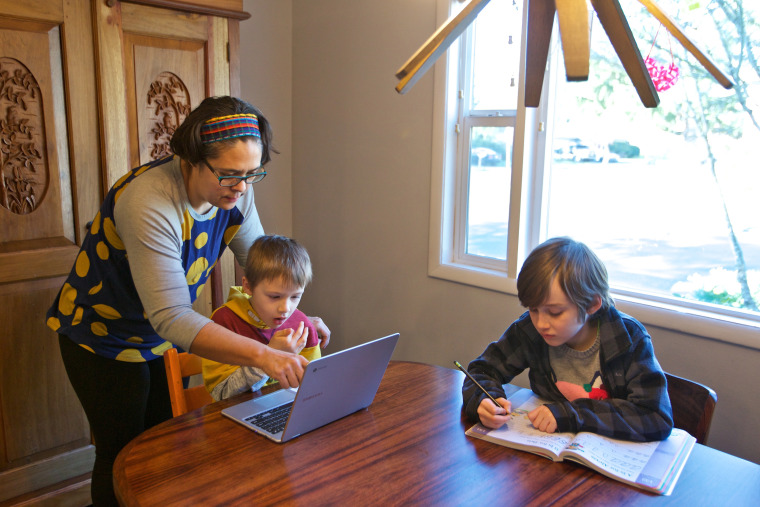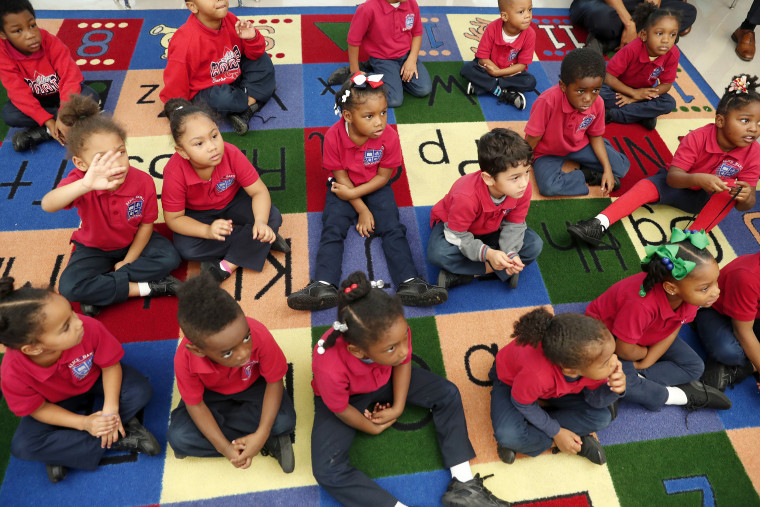WASHINGTON — Will your children be back at school this fall?
If you're having trouble answering that question, you're not alone — across the country, state and local officials are still struggling to develop plans and backups depending on the severity of the coronavirus pandemic.
But it can be argued that the degree to which in-person classes can return is the single biggest unanswered policy question of the crisis, with impacts on health, business and inequality and on elections for everything from president to county executive.
A botched reopening could have disastrous consequences that ripple across society at every level — and some experts are issuing warnings about just that scenario.
With just weeks to go before classes typically begin, education advocates complain that the federal government's response has been lethargic — the House and the Senate have held hearings on opening schools and child care facilities, but President Donald Trump and Republican leaders have been slow to craft a relief bill that might back up school budgets and fund new pandemic safety measures.
Full coverage of the coronavirus outbreak
"It's really shocking to me how little appreciation there is for the situation in Washington," said Linda Darling-Hammond, president of the Learning Policy Institute and head of the California State Board of Education. "It's not a problem that can be solved at the state level."
Plans are still in flux for state and local governments, but parents hoping for a swift return to normal are likely to be disappointed. Many districts are weighing proposals in which students would split time between virtual and in-person classes to maintainstrict social distancing inside buildings.
And as businesses and investors try to map the arc of the recovery, they should probably start with those classrooms.
"There are 78 million parents with at least one child in their household under 18. That's almost a third of the adult population," said labor economist Ernie Tedeschi, a former Treasury Department official. "A parent's ability to find and keep a job is inseparable from child care and schooling."
Fairfax County, Virginia, among the largest school districts in the country, will guarantee only at least two full school days per week. In New York City, a public school principal warned this week that her school may have space to allow only two days of remote learning for every one day of physical attendance, alarming some parents. "I wish someone would just say the quiet part loud: In the COVID economy, you're only allowed a kid OR a job," cookbook writer Deb Perelman tweeted in a widely shared thread.

For election forecasters, few political issues will touch lives more directly. If parents struggle with the new system, it could undercut Trump's sunny talk of recovery, which he has said will include a return to classrooms even as Education Secretary Betsy DeVos and federal health officials are trying to manage expectations.
Or parents could lash out at more cautious politicians if they think classroom restrictions are too strict.
"It's going to be a major issue," said Purple Strategies Managing Director Rory Cooper, a former House GOP aide. "If you can't go to work, if your kid isn't learning, if you are worried about the social effects, then you're probably going to be less favorable to incumbents."
School reopenings also run directly into race, class, gender and geographic divides that the pandemic has widened and recent protests have highlighted.
Research suggests that earlier school closures disproportionately burdened poor, minority and rural families, who were less likely to have reliable internet access or parents who could telecommute while assisting their children with learning from home.
Women, who have lost more jobs than men during the pandemic and report having taken on more child care duties, would be especially affected by any further disruption to schools.
For many families beleaguered by three months of home child care, the lack of clarity is a source of constant dread.
Andrew Ralston Jr., a lawyer in Allentown, Pennsylvania, is still anxiously waiting to hear plans for two Catholic schools his older children attend and the public school where his wife, Lisa, has been teaching remotely. One of his daughters requires a specialized education plan, and he has been deeply concerned that she has lost ground while learning online. But his wife also has asthma, which has everyone nervous about cutting corners on safety.
"There is some talk of two days in school, three at home," Ralston said. "The real nightmare is if the kids' schedules and my wife's don't overlap. When she's home teaching and the kids are also home being taught, how do I work?"
Part of the difficulty in crafting a plan is that the science behind the coronavirus is still developing. While children have so far been largely (although not entirely) spared from the worst effects, there's conflicting evidence about how likely they are to spread the virus to adults.
"I've been really discouraged by the overall lack of information about this," said Emily Oster, an economist at Brown University who is part of a group of analysts tracking coronavirus research.
While it's inevitable that some children will get sick come the fall, Oster said scientists still need more data from summer camps, day care centers and schools abroad to determine whether infections can be contained without causing large-scale outbreaks.
"The question is not 'does anybody get it?' It's 'if one person gets it, does everybody get it?'" she said.
Download the NBC News app for full coverage and alerts about the coronavirus outbreak
Students have fared well in some countries, but Israel had to re-close many of its schools this month after a rapid resurgence of the coronavirus among children and staff members, an ominous sign.
Even with this uncertainty in mind, Oster noted that many epidemiologists support reopening sooner rather than later because the damage to families, especially poor families, has been so catastrophic that it justifies the risk.
In addition to widespread evidence that children are falling behind in their educations and that parents are struggling with child care, schools are a critical source of social services like free meals.
But getting to a partial reopening is going to be difficult, even in a best-case scenario.
Staff shortages are a significant concern. Hundreds of thousands of public school teachers have been laid off, and parochial schools and child care providers are under severe strain, as well.
Many teachers are older or have health conditions that could force them to teach remotely. Pools of substitute teachers are often filled with retired teachers who face the same problem.
All of this is bad news, because following health officials' guidance and moving to smaller classrooms could require more teachers.
And monitoring children and staff members for symptoms is likely to require more nurses and protective gear. Disinfecting schools could require more janitorial staff and supplies. Children learning remotely, whether part time or full time, will often need laptops and hot spots and help to set them up and troubleshoot.
These measures require new funding, just as state and local budgets are collapsing under the strain of the pandemic. While the White House and the Republican-held Senate are taking a wait-and-see approach to the next round of relief spending, in the Democratic House, the HEROES Act would include $58 billion for K-12 schools. That would still fall short of a $250 billion request from a coalition of education advocacy groups.
If school districts decide they don't have the resources to implement reopening guidance, they will "have to stick with distance learning, because they can't do it safely," said Darling-Hammond, the president of the California education board.
Some of the dilemmas could resolve themselves, however. If cases continue to rise and public officials fail to prevent a dreaded "second wave" of outbreaks, many schools and parents may feel that they have no choice but to return to remote learning.
"Without controlling the pandemic, I think the best you can do is provide funding to make sure that schools don't go under permanently," said Tedeschi, the labor economist.

